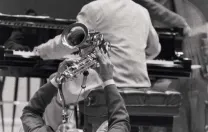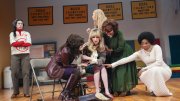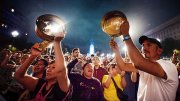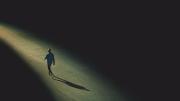It’s a Friday night at The Mad Monkfish in Cambridge’s Central Square and Yoko Miwa and her trio are performing their weekly set. The lights are dim and the Asian-fusion dishes are plated with style. For many, it’s date night, and although it costs $10 to sit in the Jazz Baroness Room—where the live performances take place—not everyone is completely tuned in. For some, music is part of the atmosphere, akin to the lipstick-red laminated seats; for others, it’s the reason they came. Miwa, a Berklee associate professor of piano whose trio is a staple in Boston, plays with unpretentious grace and fluidity. The sound reaches the back of the room, but the closer you get to the ankle-high stage, the more the nuances stand out. Her breezy, articulate phrases roll into one another like waves pulsing along the shore, inspiring some diners to turn away from their food and watch. Jazz is in the air.
The plate-glass storefront window behind the stage gives passersby a view of the trio, as external loudspeakers send Miwa’s rhythms into the street. Some people stand and listen; others have somewhere else to be. A not-insignificant number are musicians, who—juggling guitars, keyboards, saxophones, sound equipment, and even an upright bass or two—are off to their own gigs.
On any given weekend in Boston, there’s plenty of jazz to be heard. This might surprise those who think jazz hubs mean New Orleans and New York City. “Boston doesn’t have the reputation of being a great jazz city,” says Pauline Bilsky, president of the advocacy group JazzBoston. “It’s really not recognized—even here.” But those on the lookout know that Boston certainly has a part to play.
The local jazz scene began in the early twentieth century and took off in the late 1940s, as American soldiers returned from war. With support from the GI Bill, servicemen flocked to Boston’s three major music schools: the New England Conservatory of Music (NEC), Schillinger House (now Berklee College of Music), and The Boston Conservatory (now Boston Conservatory at Berklee). As Richard Vacca details in The Boston Jazz Chronicles, Boston was not just a hotbed of musical talent, but also “a training ground for jazz journalists, a magnet for music education, and a proving ground for new approaches in jazz presentation. Other cities made contributions as well, but Boston was unique in that it made major contributions to all of them.”
Proximity to New York City was a blessing and a curse. Positively, many of the world’s best artists frequently visited: Dizzy Gillespie, Artie Shaw, Glenn Miller, Duke Ellington, Thelonious Monk. Negatively, they often went home with some of Boston’s most promising young musicians in tow. Other cities may have had a bigger pool, but Boston musicians could outschool anyone. “We sort of looked down on the musical knowledge of the New York musicians because they were all there before they were ready,” said prominent avant-garde jazz artist and Boston Conservatory graduate Sam Rivers, according to Vacca. “They got on-the-job training. We waited and got ourselves together first and then we went to New York.”
Many of Boston’s most storied jazz institutions have faded away, but others have popped up. And although very few clubs and restaurants feature jazz exclusively, JazzBoston tallied 150 venues in the Greater Boston area (extending to Worcester and the North Shore) that book jazz acts with some regularity. Bilsky points in particular to the Shalin Liu Performance Center in Rockport, and Chianti Restaurant & Lounge in Beverly. Framed by floor-to-ceiling glass windows and a stunning view of the ocean, the Shalin Liu stage provides a pristine visual, as well as auditory, experience, and features widely recognized artists who might also perform at Lincoln Center or Symphony Hall. Branford Marsalis visited this September, and Grammy Award-winners Ulysses Owens Jr. and Jack DeJohnette are on this season’s docket. Chianti is a homier venue, with entertainment six nights a week, and solid Italian food. Guest artists tend to be of more regional than national acclaim, but there is plenty of talent—and no cover charge. Also of note is The Sahara Club, set in a nondescript brown building on a suburban Methuen street: it offers Tuesday-night jazz series, featuring an array of crowd-pleasing, mostly local musicians, food and bar service, and cabaret seating.
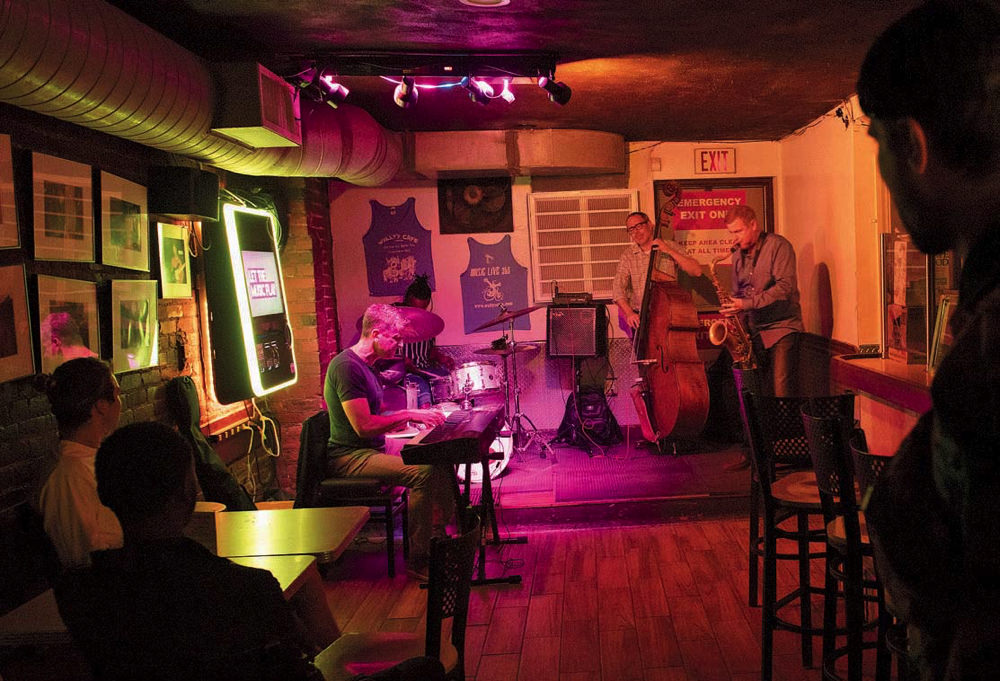
A low-key evening at Wally's, in Boston
Moving into Boston’s South End, one classic club does remain: Wally’s Café, which has been plugging away for more than 75 years. Even today, its audience skews young. On a Saturday night, an unbridled improvisatory energy hits you just as you enter through the club’s distinctive red door. About the width of two bowling lanes, the venue lacks much room to stretch out, but the restrictions do nothing to curb the passion of the crowd or the performers. Solos are rewarded with instant applause, and riffs are extemporized emphatically, with minimal breaks in the action. You can get close enough to observe the tenor sax player’s minor annoyance when a reed doesn’t respond properly, and watch as the bassist takes control during the bandleader’s bathroom break. Some 80 people can pack inside this airtight jazz haven, seven nights a week. Stepping back onto the street, you wonder how such a little room could contain so much verve.
Regattabar and Scullers Jazz Club, both located in Cambridge hotels, may lack the same powder-keg excitement, but they draw better-known acts several nights a week. Yosvany Terry, an internationally acclaimed bandleader and Harvard senior lecturer in music, suggested both venues, although he admits that he himself performs in New York City most weekends. In November, Scullers hosts two 10-time Grammy Winners: legendary jazz trumpeter Arturo Sandoval (November 8 and 9) and pianist Eddie Palmieri (November 29). Regattabar’s performances are booked through New York City’s Blue Note Jazz Club, and feature a similar talent slate. Both offer pristine environments for undistracted jazz enjoyment. No jostling or fighting your way to the front of the room is required.
At Darryl’s Corner Bar & Kitchen, a stylish soul-food spot in Boston’s South End, some voice-raising might be necessary. The music rarely falls below forte, and the bass can be felt as well as heard. Servers wait for the briefest lulls in the action so they can hear the patrons’ orders. What’s fun is the funkier feel of the music at Darryl’s—a sharpness aided by the arguably overactive speakers—and guests dance in their seats, while standing in place, and in groups near the performers. Darryl’s doesn’t book just jazz, but the musicians are good, and the food is, too. One inebriated guest recommended Slade’s Bar and Grill, a slightly cheaper soul-food joint down the block, which sometimes features live jazz. “Nothing’s like Wally’s, though,” he clarified, before sauntering out. Also in the South End is The Beehive, a quieter and more bohemian restaurant with a nightly selection of live music. Depending on where you sit, the music could be more atmosphere than draw.
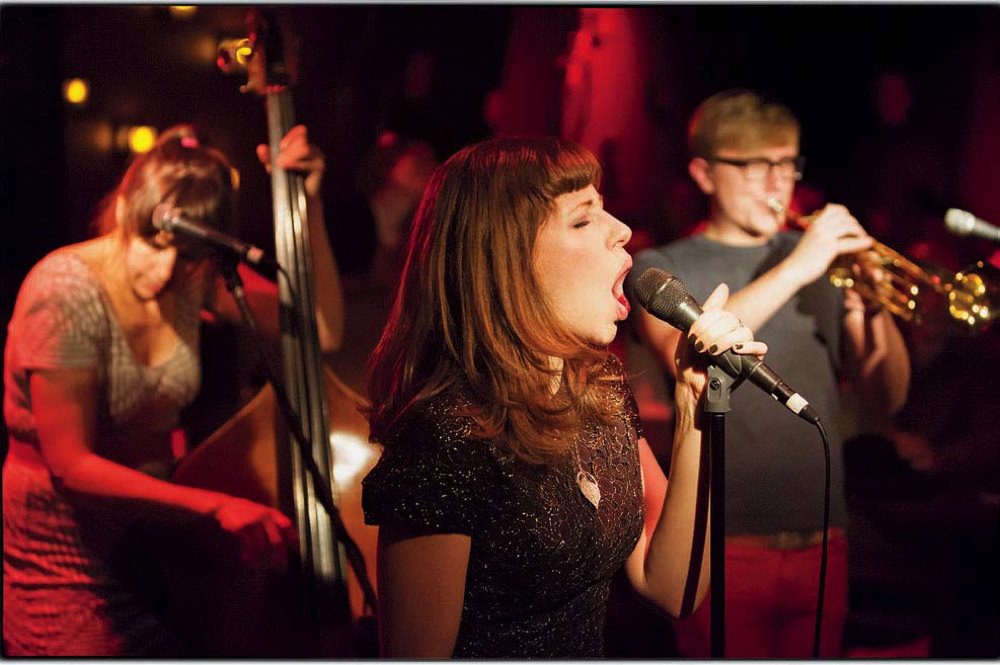
Rachael Price sings with the Boston-based group Lake Street Dive at Lizard Lounge.
Photograph courtesy of the Lizard Lounge
Just north of Harvard Square, the Lizard Lounge, recommended by Ingrid Monson, Quincy Jones professor of African-American music, presents a cozy cabaret-like viewing and listening experience and low-key pub grub. On a Saturday night, the crowd is noticeably relaxed as they listen attentively to the chilled-out headlining folk group. The featured jazz artists tend to be a bit more contemporary and experimental than those at older-school venues: Club d’Elf, a frequent Lizard Lounge performer with a steady, hypnotic sound, markets itself as a “Moroccan-dosed Psychedelic Dub Jazz Collective.” On leaving a show, it’s tough to estimate how much time has passed. The Lilypad, another Monson recommendation, is an Inman Square hot spot for modern jazz and funk. Resembling an off-campus apartment’s living room, the venue draws an audience that’s mostly college-aged, or a bit older, with many attendees sporting creative facial hair and cans of Pabst Blue Ribbon. Avant-garde and bebop are the most represented genres on the calendar—a bit more raucous than smooth jazz. On one Saturday night, the ironically named dance-funk band Jeb Bush Orchestra, whose members wore short-shorts and sweatbands, had the crowd jaunty and loose. Just down the road, Outpost 186 offers an even smaller and more experimental setting. It would be wise to enter expecting less-than-traditional tonality. The room fits only about three dozen people on metal folding chairs, and the walls are often covered in contemporary art installations. As local jazz musician and blogger Stephen Provizer has written “The skill level ranges from the competent to the ‘I can’t believe musicians as good as this are only playing for 10 people.’”
If many of Boston’s historical jazz venues have fallen out, NEC, Berklee, Harvard, and MIT have helped fill the gap. A glance at the schools’ schedules reveals numerous free, or inexpensive, concerts with some big names. NEC, with frequent free performances by faculty, students, and visiting artists, might be the top spot. At semesters’ end, students often give recitals for a grade. You’re in for good performances; they need them to graduate. Presenting organizations like Global Arts Live, Celebrity Series, and Mandorla Music have picked up the slack as well, producing shows throughout Boston, Cambridge, and Somerville. As for seasonal jazz events, don’t miss the Aardvark Jazz Orchestra’s forty-seventh annual Christmas Concert, on December 14 in Emmanuel Church, on Boston’s Newbury Street.
Boston might not have the jazz clout of New Orleans or New York City—or even of Kansas City, San Francisco, or Chicago—but that doesn’t mean it’s not a jazzy city. It’s a matter of knowing where to look, and the desire to just get swinging.
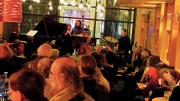
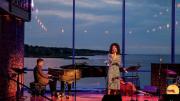
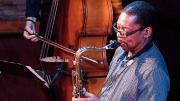
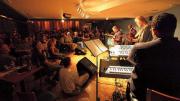
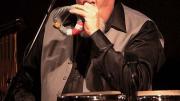
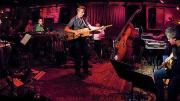
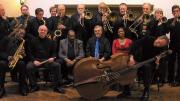
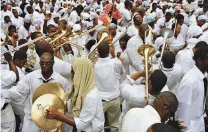 ,
,
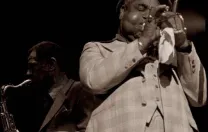 ,
,
